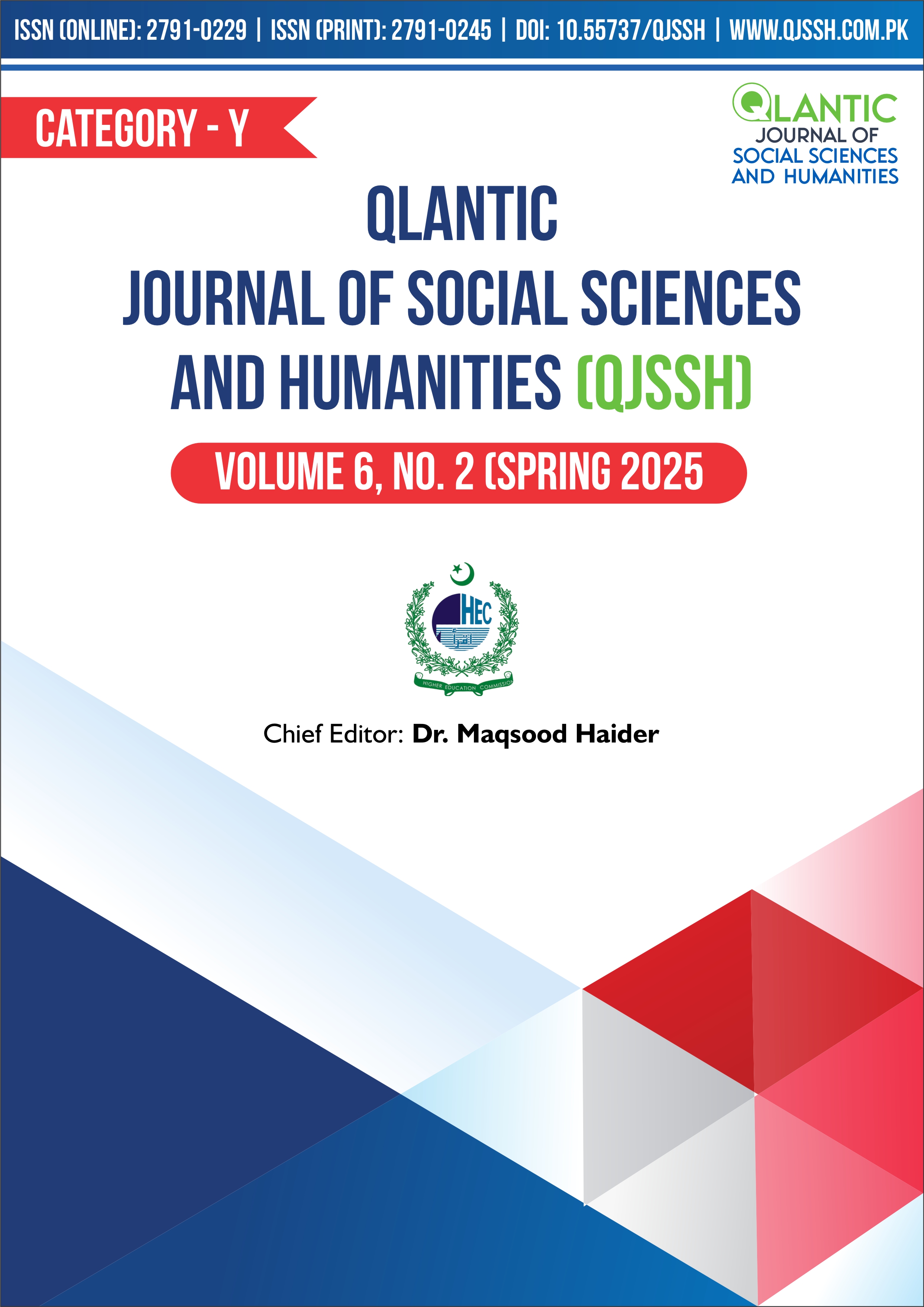Exploring Lexical and Grammatical Features in Home Fire by Kamila Shamsie
DOI:
https://doi.org/10.55737/qjssh.vi-ii.25350Keywords:
Grammatical Categories, Leech and Shorts Model, Lexical FeaturesAbstract
The purpose of the present study is to a) find the lexical features, b) discover the role of linguistic features in the text, c) examine the grammatical elements used in the novel, and d) check the sentence structure and patterns. The research design of this study was exploratory qualitative. The data for the study was derived from the novel Home Fire. After an in-depth study of the novel, the researcher gathered relevant lexical and grammatical categories from the text in the form of rough drafts and later utilized them while doing the analysis. The researcher has applied a modified Leech and Shorts (2007) model for grammatical and lexical categories to analyze the text. Nouns, verbs, adjectives, and adverbs are extracted from the text in linguistic features. At the same time, functional types of sentences and minor word classes like prepositions, conjunctions, interjections, and articles were analyzed under grammatical categories. The study's outcomes show that the writer has used mainly concrete nouns, descriptive adjectives, transitive verbs, and adverbs of manner in the mentioned text. The detailed knowledge of the text analysis can help the reader become more insightful and discerning. This study is expected to help the students and researchers in enhancing their academic writing and understanding.
References
Arigusman, A. (2018). An analysis of student’s narrative text writing: An SFL approach. International Journal of Languages, Literature and Linguistics, 4(2), 93–100. https://doi.org/10.18178/ijlll.2018.4.2.156
Best, J., and J. Kahn (1998). Research in education (8th ed.). Boston: Allyn and Bacon.
Can, A. (2009). Acquisition of English ergative verbs by Turkish students: Yesterday and today. Procedia - Social and Behavioral Sciences, 1(1), 2832–2837. https://doi.org/10.1016/j.sbspro.2009.01.050
Creswell, J. W. (2002). Research design: Qualitative, quantitative, and mixed methods approaches (2nd ed.). SAGE Publications, Inc.
Crystal, D. (2010). The Cambridge Encyclopedia of Language (3rd ed.). Cambridge University Press
Faiz, R., Azher, M., Asghar, I., & Jabeen, I. (2018). Stylistic study of adjectives in How to Get Filthy Rich in Rising Asia. International Journal of English Linguistics, 8(3), 328. https://doi.org/10.5539/ijel.v8n3p328
Fares, M., Oepen, S., & Velldal, E. (2018). Transfer and multi-task learning for noun–noun compound interpretation. In Proceedings of the 2018 Conference on Empirical Methods in Natural Language Processing (pp. 2101–2111). https://doi.org/10.18653/v1/d18-1178
Gilbert, H. G., Jr. (2002). Scientific method in practice (1st ed.). Cambridge University Press.
Goldstein, N. J., Cialdini, R. B., & Griskevicius, V. (2008). A room with a viewpoint: Using social norms to motivate environmental conservation in hotels. Journal of Consumer Research, 35(3), 472–482. https://doi.org/10.1086/586910
Hartmann, K., & Stork, F. C. (1972). Dictionary of language and linguistics. Wiley.
Katz, J. N. (2013). The three block model of universal design for learning (UDL): Engaging students in inclusive education. Canadian Journal of Education/Revue canadienne de l'éducation, 36(1), 153-194. https://www.jstor.org/stable/canajeducrevucan.36.1.153
Khokhlova, N. (2014). Understanding of abstract nouns in linguistic disciplines. Procedia - Social and Behavioral Sciences, 136, 8–11. https://doi.org/10.1016/j.sbspro.2014.05.278
Kline, M., & Demuth, K. (2014). Syntactic generalization with novel intransitive verbs. Journal of Child Language, 41(3), 543–574. https://doi.org/10.1017/S0305000913000226
Leech, G. (2007). Style in fiction: A linguistic introduction to English fictional prose (2nd ed.). Routledge & CRC Press. https://www.routledge.com/Style-in-Fiction-A-Linguistic-Introduction-to-English-Fictional-Prose/Short-Leech/p/book/9780582784093
Malik, W. H., Sadia, B., & Bughio, F. A. (2015). Style in Fiction: A Stylistic Analysis of The Bull and the She Devil. An International Research Journal of Language and Literature, 26.
Mkrtychian, N., Blagovechtchenski, E., Kurmakaeva, D., Gnedykh, D., Kostromina, S., & Shtyrov, Y. (2019). Concrete vs. Abstract Semantics: From Mental Representations to Functional Brain Mapping. Frontiers in Human Neuroscience, 13. https://doi.org/10.3389/fnhum.2019.00267
Mukundan, J., & Roslim, N. (2009). Textbook representation of prepositions. English Language Teaching, 2(4), 13–19. https://doi.org/10.5539/elt.v2n4p13
Simpson, P. (2004). Stylistics: A resource book for students. Psychology Press.
Sneddon, J. N., Adelaar, A. K., Djenar, D., & Ewing, M. (2010). Indonesian: A comprehensive grammar (2nd ed.). Routledge.
Stanley, N. (2007). Young people’s and carers’ perspectives on the mental health needs of looked-after adolescents. Child & Family Social Work, 12(3), 258–267. https://doi.org/10.1111/j.1365-2206.2007.00491.x
Tabassum, A. R., & Ahmad, S. (2015). Stylistic analysis of the short story ‘The Last Word’ by Dr. A. R. Tabassum. Advances in Language and Literary Studies, 6(3), 87–92. https://doi.org/10.7575/aiac.alls.v.6n.3p.10
Widdowson, H. G. (2014). The role of translation in language learning and teaching. In Translation: A multidisciplinary approach (pp. 222–240). Palgrave Macmillan. https://doi.org/10.1057/9781137025487_12
Yamazaki, A. K. (2001). The pragmatic function of modal verbs in scientific papers (Doctoral dissertation, Tokyo University of Marine Science Technology).
Zhang, J. (2009). Necessity of Grammar Teaching. International Education Studies, 2(2). https://doi.org/10.5539/ies.v2n2p184
Downloads
Published
Issue
Section
License

This work is licensed under a Creative Commons Attribution-NonCommercial 4.0 International License.





